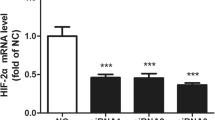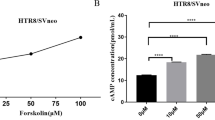Abstract
Background
Dexamethasone (DEX) induces intrauterine growth restriction (IUGR) in pregnant rats. IUGR can occur due to apoptosis of trophoblasts, which is believed to be inhibited by progesterone (P4). A group of genes called MTAs play a role in proliferation and apoptosis. MTA1 upregulates trophoblasts proliferation and differentiation, while MTA3 downregulates proliferation and induces apoptosis. Hence, we hypothesized that during IUGR, placental MTA1 decreases and MTA3 increases and this is reversed by P4 treatment.
Methods
Pregnant Sprague–Dawley rats were divided into 4 groups based on daily intraperitoneal injections: control (C, saline), DEX (DEX, 0.2 mg/kg/day), DEX and P4 (DEX + P4, DEX: 0.2 mg/kg/day, P4: 5 mg/kg/day) and P4-treated (P4, 5 mg/kg/day) groups. Injections were started on 15 dg until the day of dissection (19 or 21 dg). Gene and protein expressions of MTA1 and MTA3 were studied in the labyrinth (LZ) and basal (BZ) zones using real-time PCR and Western blotting, respectively.
Results
DEX treatment induced 18% reduction in fetal body weight (p < 0.001) and 30% reduction in placental weight (p < 0.01). Maternal P4 level was also significantly lower in DEX treated groups (p < 0.05). MTA1 expression was decreased in the LZ (gene, p < 0.001) and BZ (protein p < 0.01), while MTA3 protein expression was upregulated in the LZ with DEX treatment (p < 0.001). These changes were reversed with P4 treatment.
Conclusion
The findings of the present study indicate that DEX induces IUGR through changing the expression of placental MTA1 and MTA3 antigens and P4 improved pregnancy outcome by preventing the changes in MTAs expression.




Similar content being viewed by others
References
Bamfo JE, Odibo AO (2011) Diagnosis and management of fetal growth restriction. J Pregnancy 2011:640715
Eberle C, Fasig T, Bruseke F, Stichling S (2021) Impact of maternal prenatal stress by glucocorticoids on metabolic and cardiovascular outcomes in their offspring: A systematic scoping review. PloS One 16(1):e0245386
Rondo PH, Ferreira RF, Nogueira F, Ribeiro MC, Lobert H, Artes R (2003) Maternal psychological stress and distress as predictors of low birth weight, prematurity and intrauterine growth retardation. Eur J Clin Nutr 57(2):266–272
Moss TJ, Nitsos I, Harding R, Newnham JP (2003) Differential effects of maternal and fetal betamethasone injections in late-gestation fetal sheep. J Soc Gynecol Investig 10(8):474–479
Bevilacqua E, Brunelli R, Anceschi MM (2010) Review and meta-analysis: Benefits and risks of multiple courses of antenatal corticosteroids. J Matern Fetal Neonatal Med 23(4):244–260
Ahmadabad H, Kayvan Jafari S, Nezafat Firizi M, Abbaspour AR, Ghafoori Gharib F, Ghobadi Y, Gholizadeh S (2016) Pregnancy outcomes following the administration of high doses of dexamethasone in early pregnancy. Clin Exp Reprod Med 43(1):15–25
Yahi D, Ojo NA, Mshelia GD (2017) Influence of dexamethasone on some reproductive hormones and uterine progesterone receptor localization in pregnant Yankasa sheep in Semiarid Zones of Nigeria. J Vet Med 2017:9514861
Newbern D, Freemark M (2011) Placental hormones and the control of maternal metabolism and fetal growth. Curr Opin Endocrinol Diabetes Obes 18(6):409–416
Halasz M, Szekeres-Bartho J (2013) The role of progesterone in implantation and trophoblast invasion. J Reprod Immunol 97(1):43–50
Yovich JL, Conceicao JL, Stanger JD, Hinchliffe PM, Keane KN (2015) Mid-luteal serum progesterone concentrations govern implantation rates for cryopreserved embryo transfers conducted under hormone replacement. Reprod Biomed Online 31(2):180–191
Szekeres-Bartho J (2018) The role of progesterone in feto-maternal immunological cross talk. Med Princ Pract 27(4):301–307
Shah NM, Imami N, Johnson MR (2018) Progesterone modulation of pregnancy-related immune responses. Front Immunol 9:1293
Rider V, Talbott A, Bhusri A, Krumsick Z, Foster S, Wormington J, Kimler BF (2016) WINGLESS (WNT) signaling is a progesterone target for rat uterine stromal cell proliferation. J Endocrinol 229(2):197–207
Wang Y, Hanifi-Moghaddam P, Hanekamp EE, Kloosterboer HJ, Franken P, Veldscholte J, van Doorn HC, Ewing PC, Kim JJ, Grootegoed JA, Burger CW, Fodde R, Blok LJ (2009) Progesterone inhibition of Wnt/beta-catenin signaling in normal endometrium and endometrial cancer. Clin Cancer Res 15(18):5784–5793
Kim M, Park HJ, Seol JW, Jang JY, Cho YS, Kim KR, Choi Y, Lydon JP, Demayo FJ, Shibuya M, Ferrara N, Sung HK, Nagy A, Alitalo K, Koh GY (2013) VEGF-A regulated by progesterone governs uterine angiogenesis and vascular remodelling during pregnancy. EMBO Mol Med 5(9):1415–1430
Pang Y, Dong J, Thomas P (2015) Progesterone increases nitric oxide synthesis in human vascular endothelial cells through activation of membrane progesterone receptor-alpha. Am J Physiol Endocrinol Metab 308(10):E899-911
Wang Y, Abrahams VM, Luo G, Norwitz NG, Snegovskikh VV, Ng SW, Norwitz ER (2018) Progesterone inhibits apoptosis in fetal membranes by altering expression of both pro- and antiapoptotic proteins. Reprod Sci 25(8):1161–1167
Liu J, Matsuo H, Laoag-Fernandez JB, Xu Q, Maruo T (2007) The effects of progesterone on apoptosis in the human trophoblast-derived HTR-8/SV neo cells. Mol Hum Reprod 13(12):869–874
Morrissy S, Xu B, Aguilar D, Zhang J, Chen QM (2010) Inhibition of apoptosis by progesterone in cardiomyocytes. Aging Cell 9(5):799–809
Burton GJ, Woods AW, Jauniaux E, Kingdom JC (2009) Rheological and physiological consequences of conversion of the maternal spiral arteries for uteroplacental blood flow during human pregnancy. Placenta 30(6):473–482
Al-Bader MD, Jasem SA, Kilarkaje N (2016) Carbenoxolone exposure during late gestation in rats alters placental expressions of p53 and estrogen receptors. Eur J Pharmacol 791:675–685
Alqaryyan M, Kilarkaje N, Mouihate A, Al-Bader MD (2017) Dexamethasone-induced intrauterine growth restriction is associated with altered expressions of metastasis tumor antigens and cell cycle control proteins in rat placentas. Reprod Sci 24(8):1164–1175
Fonseca BM, Correia-da-Silva G, Teixeira NA (2012) The rat as an animal model for fetoplacental development: a reappraisal of the post-implantation period. Reprod Biol 12(2):97–118
Romero R, Nicolaides K, Conde-Agudelo A, Tabor A, O’Brien JM, Cetingoz E, Da Fonseca E, Creasy GW, Klein K, Rode L, Soma-Pillay P, Fusey S, Cam C, Alfirevic Z, Hassan SS (2012) Vaginal progesterone in women with an asymptomatic sonographic short cervix in the midtrimester decreases preterm delivery and neonatal morbidity: a systematic review and metaanalysis of individual patient data. Am J Obstet Gynecol 206(2):124e1-19
Hassan SS, Romero R, Vidyadhari D, Fusey S, Baxter JK, Khandelwal M, Vijayaraghavan J, Trivedi Y, Soma-Pillay P, Sambarey P, Dayal A, Potapov V, O’Brien J, Astakhov V, Yuzko O, Kinzler W, Dattel B, Sehdev H, Mazheika L, Manchulenko D, Gervasi MT, Sullivan L, Conde-Agudelo A, Phillips JA, Creasy GW, Trial P (2011) Vaginal progesterone reduces the rate of preterm birth in women with a sonographic short cervix: a multicenter, randomized, double-blind, placebo-controlled trial. Ultrasound Obstet Gynecol 38(1):18–31
Kumar A, Begum N, Prasad S, Aggarwal S, Sharma S (2014) Oral dydrogesterone treatment during early pregnancy to prevent recurrent pregnancy loss and its role in modulation of cytokine production: a double-blind, randomized, parallel, placebo-controlled trial. Fertil Steril 102(5):1357-1363 e3
Wadhwa L, Batra S, Tempe A (2013) Role of dydrogesterone in the treatment of idiopathic IUGR, International Journal of Reproduction, Contraception. Obstet Gynecol 2(2):157
Zarean E, Mostajeran F, Dayani Z (2018) Effect of dydrogesterone on the outcome of idiopathic intrauterine growth restriction: a double-blind clinical trial study. Adv Biomed Res 7:93
Kumar R, Wang RA, Bagheri-Yarmand R (2003) Emerging roles of MTA family members in human cancers. Semin Oncol 30(5 Suppl 16):30–37
Manavathi B, Singh K, Kumar R (2007) MTA family of coregulators in nuclear receptor biology and pathology. Nucl Recept Signal 5:e010
Manavathi B, Kumar R (2007) Metastasis tumor antigens, an emerging family of multifaceted master coregulators. J Biol Chem 282(3):1529–1533
Bruning A, Makovitzky J, Gingelmaier A, Friese K, Mylonas I (2009) The metastasis-associated genes MTA1 and MTA3 are abundantly expressed in human placenta and chorionic carcinoma cells. Histochem Cell Biol 132(1):33–38
Zhang H, Singh RR, Talukder AH, Kumar R (2006) Metastatic tumor antigen 3 is a direct corepressor of the Wnt4 pathway. Genes Dev 20(21):2943–2948
Shoener JA, Baig R, Page KC (2006) Prenatal exposure to dexamethasone alters hippocampal drive on hypothalamic-pituitary-adrenal axis activity in adult male rats. Am J Physiol Regul Integr Comp Physiol 290(5):R1366–R1373
Hashimoto H, Eto T, Endo K, Itai G, Kamisako T, Suemizu H, Ito M (2010) Comparative study of doses of exogenous progesterone administration needed to delay parturition in Jcl:MCH(ICR) mice. Exp Anim 59(4):521–524
Furukawa S, Hayashi S, Usuda K, Abe M, Hagio S, Ogawa I (2011) Toxicological pathology in the rat placenta. J Toxicol Pathol 24(2):95–111
Romero A, Villamayor F, Grau MT, Sacristan A, Ortiz JA (1992) Relationship between fetal weight and litter size in rats: application to reproductive toxicology studies. Reprod Toxicol 6(5):453–456
Freetly HC, Leymaster KA (2004) Relationship between litter birth weight and litter size in six breeds of sheep. J Anim Sci 82(2):612–618
Al-Bader MD, Kilarkaje N, El-Farra A, Al-Abdallah AA (2015) Expression and subcellular localization of metastasis-associated protein 1, its short form, and estrogen receptors in rat placenta. Reprod Sci 22(4):484–494
Al-Bader M, Kilarkaje N (2015) Effects of bleomycin, etoposide and cisplatin treatment on Leydig cell structure and transcription of steroidogenic enzymes in rat testis. Eur J Pharmacol 747:150–159
Livak KJ, Schmittgen TD (2001) Analysis of relative gene expression data using real-time quantitative PCR and the 2(-Delta Delta C(T)) Method. Methods 25(4):402–408
Vaughan OR, Sferruzzi-Perri AN, Coan PM, Fowden AL (2013) Adaptations in placental phenotype depend on route and timing of maternal dexamethasone administration in mice. Biol Reprod 89(4):80
Waddell BJ, Hisheh S, Dharmarajan AM, Burton PJ (2000) Apoptosis in rat placenta is zone-dependent and stimulated by glucocorticoids. Biol Reprod 63(6):1913–1917
Ain R, Canham LN, Soares MJ (2005) Dexamethasone-induced intrauterine growth restriction impacts the placental prolactin family, insulin-like growth factor-II and the Akt signaling pathway. J Endocrinol 185(2):253–263
Norwitz ER, Caughey AB (2011) Progesterone supplementation and the prevention of preterm birth. Rev Obstet Gynecol 4(2):60–72
Blackwell LF, Cooke DG, Brown S (2018) The use of estrone-3-glucuronide and pregnanediol-3-glucuronide excretion rates to navigate the continuum of ovarian activity. Front Public Health 6:153
Agular BM, Vinggaard AM, Vind C (1992) Regulation by dexamethasone of the 3 beta-hydroxysteroid dehydrogenase activity in adult rat Leydig cells. J Steroid Biochem Mol Biol 43(6):565–571
Acknowledgement
We would like to acknowledge the Research Sector, Kuwait University (Grant No. MY01/17) for funding this project.
Funding
This study was funded by the Research Sector, Kuwait University (Grant No. MY01/17).
Author information
Authors and Affiliations
Corresponding author
Ethics declarations
Conflict of interest
Author Prof. Maie D. Al-Bader declares that she has no conflict of interest. Author Dr. Mariam M. Alawadhi declares that she has no conflict of interest. Author Dr. Farah R M Al Shammari declares that she has no conflict of interest. Author Dr. Fatemah H R Mulla Ali declares that she has no conflict of interest. Author Dr. Rama Jamal Almatar declares that she has no conflict of interest. Author Dr. Ayat Hassan Al-Duwaikhi declares that she has no conflict of interest.
Ethical approval
All applicable international, national, and/or institutional guidelines for the care and use of animals were followed.
Additional information
Publisher's Note
Springer Nature remains neutral with regard to jurisdictional claims in published maps and institutional affiliations.
Supplementary Information
Below is the link to the electronic supplementary material.
Rights and permissions
About this article
Cite this article
Alawadhi, M.M., Al Shammari, F., Ali, F.M. et al. The effect of progesterone administration on the expression of metastasis tumor antigens (MTA1 and MTA3) in placentas of normal and dexamethasone-treated rats. Mol Biol Rep 49, 1935–1943 (2022). https://doi.org/10.1007/s11033-021-07005-5
Received:
Accepted:
Published:
Issue Date:
DOI: https://doi.org/10.1007/s11033-021-07005-5




